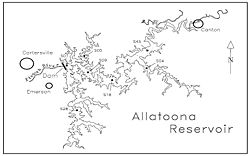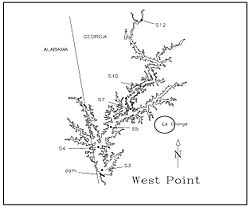Monitoring:Nutrients
From CEQUALW2 Wiki
Jump to navigationJump to search
Model Application: Point/Nonpoint Nutrient Loadings
Objectives
The objective of this[1] study was to provide a calibrated water quality model for Allatoona and West Point Lakes capable of predicting future water quality conditions resulting from changes in water allocations, point/nonpoint nutrient loadings, and reservoir operations.
The following nine water quality state variables and their kinetics interactions were included in this CE-QUAL-W2 model:
- Labile dissolved organic matter (LDOM)
- Refractory dissolved organic matter (RDOM)
- Detritus
- Phytoplankton
- Phosphate phosphorous
- Ammonia nitrogen
- Nitrate + nitrite nitrogen
- Dissolved oxygen (DO)
- Organic sediments
The state variables that were not included are conservative tracer, coliform bacteria, total dissolved solids or salinity, inorganic suspended solids, total inorganic carbon, alkalinity, total iron, and biochemical oxygen demand (BOD).
Data Needs
- Geometric Data
- Bathymetry: Bathymetry data was gathered from sediment range data provided by the Mobile District
- Initial Conditions: Initial conditions in the model can be set by (A) initializing all cells in the grid to a single value, (B) initializing all cells in the grid based on vertical variations, or (C) initializing all cells in the grid based on vertical and longitudinal variations.
- Water Surface Elevation
- Temperature: When the start of simulation was at a time when conditions were essentially isothermal, option (A) was used to set initial conditions for temperature and DO. If the simulation started when the lake was more stratified, option (B) was used.
- Water quality constituents: For all calibration years, initial conditions for phosphorous, ammonium, nitrate-nitrite, algae, LDOM, RDOM, labile particulate organic matter (LPOM), and refractory particulate organic matter (RPOM) were set using option (A) since there was little variation in concentration throughout the reservoirs.
- Boundary Conditions
- Inflows: Mobile District provided calculated daily average inflows measured every hour for the years 1979, 1996, and 1997 for West Point and 1992, 1993, 1996, and 1997 for Allatoona. Inflows were calculated based on daily average outflows and changes in water surface elevation. During calibration, discrepancies in the computed and observed water surface elevations were reconciled by adding or subtracting the appropriate amount of flow using the distributed tributary option.
- Outflows: Mobile District provided daily average outflows for all calibration years for Allatoona and 1979 and 1997 for West Point. Outflows for 1996 in West Point were furnished on an hourly basis.
- Temperature: Only monthly inflow temperature data were available for the main branch of West Point and Allatoona. Missing data were filled in using a program that uses meteorological data and depth of the stream to calculate water temperatures. Temperatures were then adjusted to match the values at the most upstream lake station since they were most affected by the upstream inflow temperatures.
- Water Quality: Very little water quality data was available. When observed constituent concentrations were not available at the boundary of the grid for each reservoir, data at the most upstream station were used. These were then adjusted to match the observed profiles at the most upstream lake station. Although inflow concentrations of LDOM, RDOM, and LPOM were not monitored at either lake, their boundary conditions were estimated from total organic carbon (TOC). Inflow algal concentrations were estimated from chlorophyll a (chla) data.
- Meteorology: Hourly meteorology was obtained from the U.S. Air Force Environmental Technical Applications Center in Asheville, NC for Columbus and Atlanta, GA. Data required for CE-QUAL-W2 for surface heat exchange were air temperature, dew point temperature, wind speed and direction, and cloud cover.
Monitoring Needs
- In-Pool Data
- Temperature Profiles
- Dissolved Oxygen (DO) Profiles
- In-pool data for Allatoona were collected monthly by the A.L. Burruss Institute at Kennesaw State College and Georgia Environmental Protection Division (GEPD) from 1992-1994 as part of the USEPA Clean Lakes Program and additionally in 1996.
- In-pool data for West Point for 1979 were obtained from a report. Data for 1996 and 1997 were received from GEPD.

